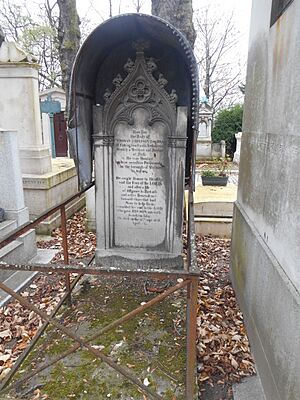Thomas Thompson (1754–1828) facts for kids
Quick facts for kids
Thomas Thompson
|
|
|---|---|
| Born | 1754 |
| Died | 1828 Paris
|
| Nationality | British |
| Spouse(s) | Philothea Perronet |
| Children | 3 sons, 2 daughters |
Thomas Thompson (1754–1828) was an important British figure. He was a successful banker from Kingston upon Hull and also a Wesleyan preacher. He was the father of Thomas Perronet Thompson, who became a well-known politician. Thomas Thompson had a large, beautiful house called Cottingham Castle built in Cottingham, East Riding of Yorkshire.
Contents
The Early Life of Thomas Thompson
Thomas Thompson was born on April 5, 1754. He came from a simple background. His father was a farmer in Owborough Grange, a place near Swine, East Riding of Yorkshire. Thomas received his education from a local reverend named William Stead.
On August 29, 1781, Thomas Thompson married Philothea Perronet. Her grandfather was Vincent Perronet, a notable religious leader.
Thomas Thompson's Business Career
Thomas Thompson started his career working as a clerk. He worked for fourteen years for a company called Wilberforce and Smith in Hull. This company was involved in both banking and trade.
In 1784, Abel Smith, one of the company's partners, recognized Thomas's talent. He made Thomas the manager of their bank branch in Hull. Just four years later, in 1788, Thomas became a partner in the bank and the trading business.
Thomas Thompson also invested in other companies. He bought shares in Sykes, Son & Co., which was a metal trading company in Hull. He also invested in the Hull Dock Company. This company managed the docks where ships loaded and unloaded goods. In 1812, Thomas became the chairman of the Hull Dock Company.
Thomas Thompson as a Member of Parliament
In 1807, Thomas Thompson became a Member of Parliament (MP). He represented the area of Midhurst. This area was controlled by Lord Carrington, who was Abel Smith's son. As an MP, Thomas generally supported the views of those who helped him get elected.
However, Thomas Thompson felt that being an MP was not his best role. He once said that Lord Carrington had "spoiled a very good banker and made a very bad MP." He decided to leave his role as an MP in 1818.
Fighting Against Slavery
Thomas Thompson was strongly against slavery. He worked with William Wilberforce, who was a famous leader in the movement to end slavery. Thomas was part of the Anti-Slavery Association. He was also a member of a group called the Clapham Sect, which was a group of wealthy and influential people who worked for social change.
Later Life and Legacy
By the early 1800s, Thomas Thompson had become very rich. He built a large and impressive house for his family, which was completed by 1816. This house was known as Cottingham Castle.
Thomas Thompson was also a lay preacher for the Methodist church. This means he was a religious leader, but not a full-time minister. He gave money to help build new chapels. He cared deeply about poor people, especially those who had to live in workhouses. Workhouses were places where poor people could live and work, but conditions were often very harsh.
To help the poor, Thomas created a "Pauper Village" in Cottingham. He provided land to poor families so they could live and work. This village was later renamed New Village in 1829. He also wrote a book called A History of the Church and Priory of Swine, in Holderness.
Thomas Thompson retired and passed away in Paris on September 14, 1828. He was buried in the Père Lachaise cemetery.
His son, Thomas Perronet Thompson (1783–1869), followed in his footsteps. He became a Member of Parliament, a governor of Sierra Leone, and an important reformer. Thomas Thompson's granddaughter later married Nevil Sidgwick, a well-known chemist.


